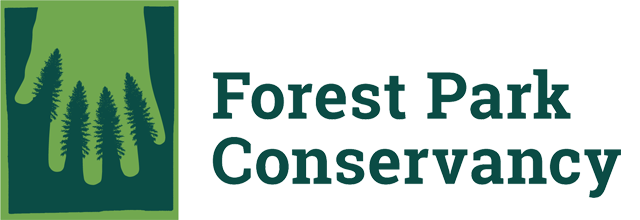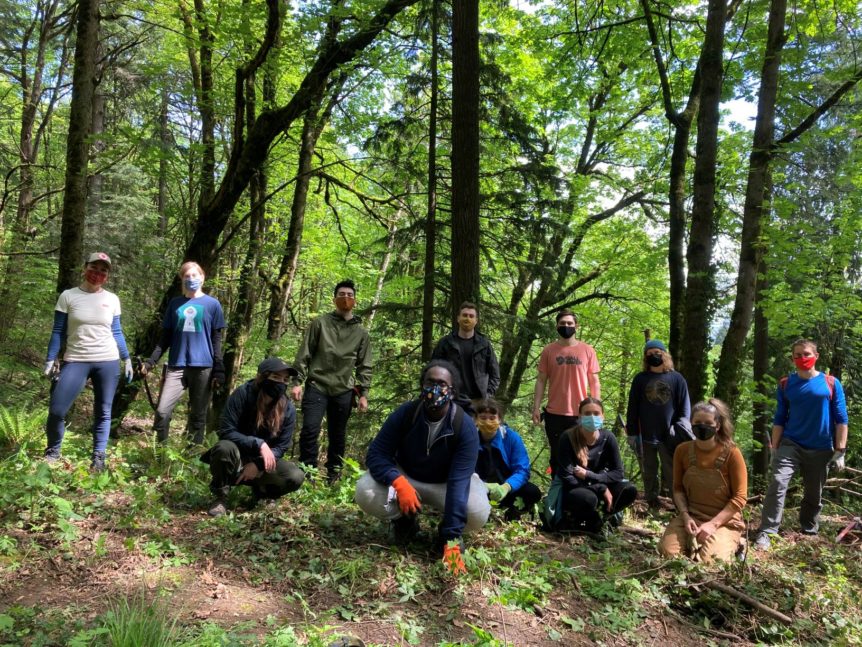This last Winter, Forest Park Conservancy (FPC) worked alongside Portland Park and Recreation (PP&R) to identify vegetation restoration work to ensure the success of an area adjacent to the Upper Holman Lane Trail restoration project. This project began being called “The Holman Wedge” project and is an excellent example of what we can accomplish in collaboration with FPC staff, neighbors, PP&R, and volunteers working together to restore Forest Park.
Hear from FPC’s Executive Director about the project below!
Forest Park, an expanse of more than 5,200 acres in the heart of the metropolitan region, is a Portland icon. It helps define the region’s identity and character and provides recreational opportunities and ecological services that help support our way of life. Forest Park also provides critical habitat for a wide array of native flora and fauna, including over 100 native birds and more than 50 native mammals. The Park also features more than 80 miles of trails and is enjoyed by thousands of nature lovers and recreational users each year. It is one of the region’s treasures, appreciated even by those who have never stepped foot within its borders.
One factor contributing to Forest Park’s ecological health is its existing connectivity to the Oregon Coast Range and other nearby natural features. Unfortunately, several factors have the potential to undermine the long-term integrity of these ecological corridors. One prominent factor is the presence of non-native invasive weeds, which do not recognize jurisdictional boundaries. As such, where possible, it is imperative that invasive species management and related habitat restoration work be initiated on publicly and privately owned property in close proximity to Forest Park.
Before the Greater Forest Park Conservation Initiative (GFPCI) was even launched in 2013, initiative partners understood the critical role that habitat restoration and invasive weed removal on private land played, in enhancing biodiversity corridors and helping to protect Forest Park from the non-native weed species that invade Forest Park from lands adjacent to the park. Knowing that conservation issues extend way beyond the boundaries of Forest Park, is one of the main reasons why the Greater Forest Park Conservation Initiative was even launched. To address these needs in private land, FPC in coordination with WMSWCD established the Perimeter Program, which is a collaborative effort to identify and restore priority areas on lands directly adjacent to Forest Park.
The Forest Park Perimeter Program was also established to help raise awareness around non-native invasive plant species and inspire landowners to initiate habitat restoration projects on their property. FPC and WMSWCD help make resources and tools available and offer private landowners an array of options including the development of strategies to remove invasive weeds from their property as well as re-vegetation efforts and long-term monitoring. Habitat restoration projects on property surrounding Forest Park will effectively expand the overall acreage of Forest Park’s wildlife habitat without the need for broad land acquisition efforts.
The Holman Wedge is a series of properties, that together, encompass 13 acres and includes 4 landowners near Holman Lane in Forest Park. The Holman Wedge was identified as a priority area and was initially established as a pilot project to build relationships with private landowners in preparation for the GFPCI being launched. This section of private land, known as the “Holman Wedge”, is a perfect example of the critical role that the private lands play in enhancing the overall health of Forest Park and important biodiversity corridors within the greater Forest Park ecosystem.

